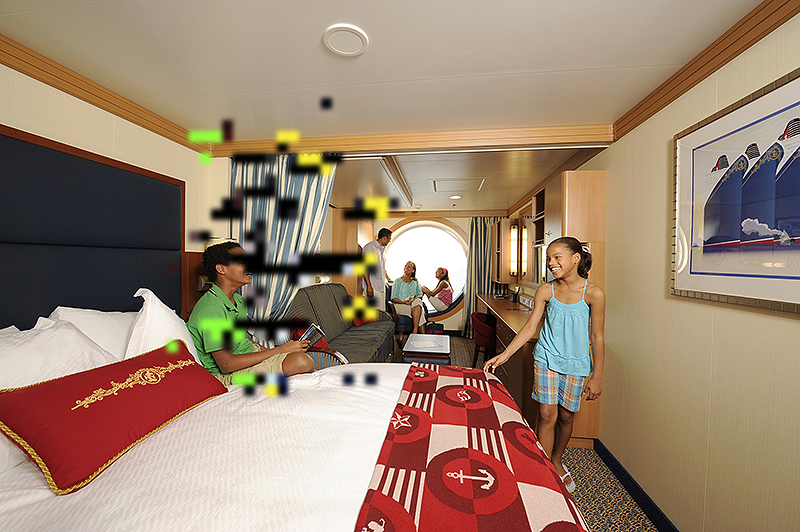A disclaimer. I'm an EE, not an astrophysicist. My own answer is coming from the "... but I stayed at a Holiday Inn last night!" perspective. And I rank my own understanding low enough (hence the reason for asking the question) that Holiday Inn could legitimately be considered an accredited source of doctoral degrees. Fair warning, let's begin.
T=0!
Many of the answers and comments pointed out that Victoria's actual time spend looking at the stars while at light speed is zero. They're absolutely correct. To be fair, I did not explain events along an axis of time. Everybody's right, Victoria couldn't walk up to the window while the ship was traveling at the speed of light. So, the Captain announces that the ship will hit lightspeed "soon" and everybody should get to a window. Victoria arrives at the window while V<c, experiences V=c, and then V<c. What's left in her eyes includes everything that happened while V=c even if her brain can't process it until V<c.
However, some of the answers/comments seem to think that time action has stopped for Victoria (and the incoming photons) while V=c. Nothing could be further from the truth. She experienced every millimeter of the voyage while traveling at the speed of light. So did all those photons out in space. Relativity doesn't mean everything stops, it means everything happens simultaneously and instantly.
All those photons... striking poor Victoria's eyes at the same moment. @Renan's answer points out the most likely outcome. But there are complications, some brought out in one answer, others in another. Let's walk through it one step at a time. First, some charts showing time, distance, and velocity.

The figure on the left shows us velocity vs. distance. Distance is involved. Victoria's time may not advance, but the distance is being covered. So my question could have been asked (and perhaps should have been asked), "from some point D0 when V=c until
some point D1 when V≠c, what did Victoria experience from her brain's visual perspective?" (Even that might have been closed. Relativity can make one's head hurt something awful. So can paintings by Picasso. It's probably all the same problem.)
The figure in the middle shows us Te or the "time experienced by Victoria" vs. distance. Yeah... I didn't mark D0 and D1 on the charts, but they're the points along D where V=c begin and end. From the perspective of a stationary observer, time experienced by Victoria (Te) slows down while approaching and leaving V=c.
The figure on the right shows (*ahem*) what Victoria experienced from our point of view, from Victoria's point of view (people will point out how nasty that description is. Yeah. I get it.). Or Te vs T. Time for Victoria (even though she doesn't perceive it) slows to zero then picks up again. (BTW, this is commonly misinterpreted as time travel. It isn't. Frankly, it's not much different from perfect cyronics. But that's another discussion. Probably one involving Buck Rogers.)
My point is, everything that occurs during the transit between D0 and D1 is experienced by Victoria in one magical (and massive) instantaneous burst.
But what happens?
This is where Doppler, Lorentz, Einstein, a bunch of other folks, and a bunch of people on this site (all smarter than myself) all chip in to create a lovely soup. We're going to add effects one effect at a time. Yup, I'm assuming effects are cumulative. They probably aren't, but remember that spherical horse (why Wiki has it as a spherical cow I'll never know. It was always a horse in my classes.). Let's start with @Hoyle'sGhost's answer and the doppler effect.
let's assume that, looking out the starboard viewport, all you saw was a field of uniform white. That means a lot of photons of all kinds of wavelengths that Victoria's eyes interpret as a smooth, comfortable, field of white. Like this:

You can edit this answer to see that I really did load a 50x50 pixel white square. It's there. Trust me. As the ship accelerates, photons start shifting. Photons shift red to the left, blue to the right, and the faster we go the more they shift. The important thing to remember is that photons approaching the ship perpendicular to the travel vector aren't shifted. You can experience this audibly with a train. When it's right in front of you, it sounds normal. Oh, we're really bookin', so a bunch of these photons are shifted outside what Victoria can see. Maybe something almost certainly not like this:
(An astute observer will realize that I have the honking picture upside down. She's looking out the starboard port, which means it should have been blue to the left, red to the right. Rats. It's late, so I'm not going to change it. You'll get the picture.)

OK. Next we need to deal with @Muuski's and @Damon's answers. One of the most amazing advances in race car video games (occurring back in the 80s, as I recall) was the advent of depth perception: that we perceive objects closer to us to move by more quickly than objects far away. I'm sure there's a fancy word for this effect — I just can't remember it. The reality in our case is that, as @Muuski reminds us, space is really empty and stars are really far away. But we're in a ship traveling at the speed of light across a distance of light years (more faults of my question: no start point and no end point). But even if we were traveling only one or two dozen light years, there are stars that would shift position (perceptually from Victoria's POV, of course) that in the T=0 moment she experiences during V=c travel, a line would be drawn by that star's photons across her retina due to the motion of the ship along D (see figures above). Of course, the more distant stars would remain dots. And all this is doppler shifted (oh, BTW, I'm ignoring relativistic doppler shifting for the sake of my explanation. Another spherical horse.) So, now we get...

Which is where Star Trek stopped representing the truth, if any of what they did is true in the first place.
Finally, after an amazing conversation with @StarfishPrime that I'm pretty sure impressed me a great deal more than it impressed him it seems that some magic happens next. Magic, I say, because when it comes to future light cones, past light cones, lorentz contraction, and the cool math he mentions in his answer, the light's going to shift boward (or forward, but toward the bow, either way). Since precious Victoria is looking our the starboard viewport, I expect it to shift to her left (fool me once...). It will also contract toward a center point, though I'm not convinced completely as she's not looking out the front of the ship (go read that conversation and realize there's a boatload of data that I couldn't access for better understanding. Remember, Holiday Inn...).

And that brings us back to @Renan's post. All those photons impacting on the ship over all that distance... (yeah, Starfish, I know you don't think this'll happen. The pancake. I'm just not convinced. Future/past cones and stuff.) all while little Victoria sits there, immobilized in time (so to speak) because everything's happening simultaneously at T=0.

That picture really doesn't do the moment justice. All those bright white, red, and blue spots? They'd be blinding. Completely blinding, like looking into a camera flash, but much more precise. So much so that when poor Victoria looks away (V<c) to see people around her, it would look something like this:

The green spots are where the red from the red-shifted light affected her eyes (overstimulating red leaves a green spot in your vision). Likewise, yellow for the blue-shifted light. I'm probably wrong on this one — they'd be black, too, due to the brightness of the flash — but it's possible that you'd get some temporary green and yellow from the weaker (darker) shifts.
Or maybe @Hoyle'sGhost is right and she'd see nothing due to @Renan's answer that the flash would blind her completely. But the above picture is much more fun — and it's what you get when you use spherical horses.
Am I right? HeckifIknow. But the the lawsuit filed by little Victoria Luise's parents against the cruise liner and its captain for not having the brains to close the shutters while the ship was at V=c would make a good story.









